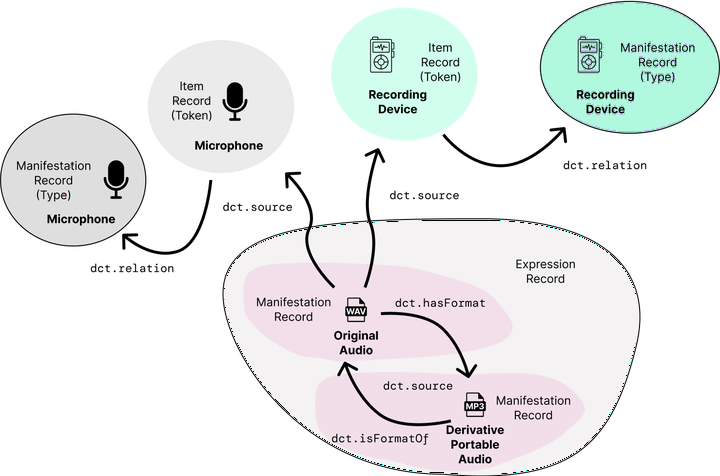Dublin Core's DCMIType ‘PhysicalObject’ and its use across the Open Language Archives Community

Abstract
I explore the nature of linguistic and anthropological language-focused artifact records which use the DCMIType attribute ‘PhysicalObject’ (DCMI 2018). Dublin Core’s DCMIType vocabulary is an important access point for users. It allows them to quickly access resources based on experiential modality types, e.g., MovingImage, Sound, Text, Image, Software, etc. Zavalin and Zavalina (2023), while evaluating student curators using Dublin Core (DC), suggest that the use of the DCMIType ‘PhysicalObject’ is challenging for curators, and its use is subject to consistency errors. The semantics of ‘PhysicalObject’ can be confusing for non-digital resources, and its DC provided definition is limiting due to its applicability only to inanimate objects.
I analyze the 480,812 records (representing 61 data providers) from the Open Language Archives Community (OLAC) (as of April 4th, 2023). Data providers supply DC metadata to OLAC via an OAI feed using the OLAC application profile (Bird & Simons 2001, 2003; Simons & Bird 2003; Simons et al 2008). Paterson’s (2022) analysis of Paterson (2021) reports 83.3 percent of OLAC records declared a DCMIType value. However, the aggregation has grown by about 37,000 records since. Across the range of OLAC providers, currently 16 records use the DCMIType ‘PhysicalObject’, up from 4 records in 2021. The current study compares consistency and accuracy of records in circulation with the results of classroom records reported on by Zavalin and Zavalina.
Untapped potential exists for the use of ‘PhysicalObject’ by language-scholars to describe their scholarly work—opportunities for greater technical descriptions of language documentation collections. Cultural heritage stewards could integrate records of physical objects with existing OLAC records. I discuss these potential scenarios. A richer understanding of the applicability of ‘PhysicalObject’ can lead to a more diverse participation in the OLAC network of repositories for the benefit of ethnolinguistic minorities seeking information on their cultural heritage.
Abstract Bibliography
- Bird & Simons (2003)
- Bird, S. & Simons, G. (2003). Extending Dublin Core Metadata to Support the Description and Discovery of Language Resources. Computers and the Humanities, 37(4). 375–388. https://doi.org/10.1023/A:1025720518994
- Bird & Simons (2001)
- Bird, S. & Simons, G. (2001). The OLAC metadata set and controlled vocabularies. In DeClerck, T., Krauwer, S. & Rosner, M. (Eds.), Proceedings of ACL/EACL Workshop on Sharing Tools and Resources for Research and Education. (pp. 7–18). EACL-ACL; elsnet. Retrieved from https://www.aclweb.org/anthology/W01-1506
- (2018)
- (2018, 10/23). Retrieved from https://www.dublincore.org/specifications/dublin-core/dcmi-terms/dcmitype/PhysicalObject/
- Paterson III (2021)
- Paterson III, H. (2021). OLAC Nightly Data Dump (XML) from 18 July 2021. OLAC: Open Language Archives Community. https://doi.org/10.5281/ZENODO.5112131
- Paterson III (2022)
- Paterson III, H. (2022). Where Have All the Collections Gone?: Analysis of OLAC Data Contributors’ use of DCMIType ‘Collection’. Society of American Archivists. Retrieved from https://www2.archivists.org/am2021/research-forum-2021/agenda#peer
- Simons & Bird (2003)
- Simons, G. & Bird, S. (2003). Building an Open Language Archives Community on the OAI foundation. Library Hi Tech, 21(2). 210–218. https://doi.org/10.1108/07378830310479848
- Simons, Bird & Spanne (2008)
- (N.A.). (2008). OLAC Metadata Usage Guidelines ( 2008-07-11 ). Open Language Archive Community. Retrieved from http://www.language-archives.org/NOTE/usage-20080711.html
- Zavalin & Zavalina (2023)
- Zavalin, V. & Zavalina, O. (2023). Exploration of Accuracy, Completeness and Consistency in Metadata for Physical Objects in Museum Collections. In Sserwanga, I., Goulding, A., Moulaison-Sandy, H., Du, J., Soares, A., Hessami, V. & Frank, R. (Eds.), Information for a Better World: Normality, Virtuality, Physicality, Inclusivity. (pp. 83–90). Springer Nature Switzerland. https://doi.org/10.1007/978-3-031-28032-0_7
Content Mediums: